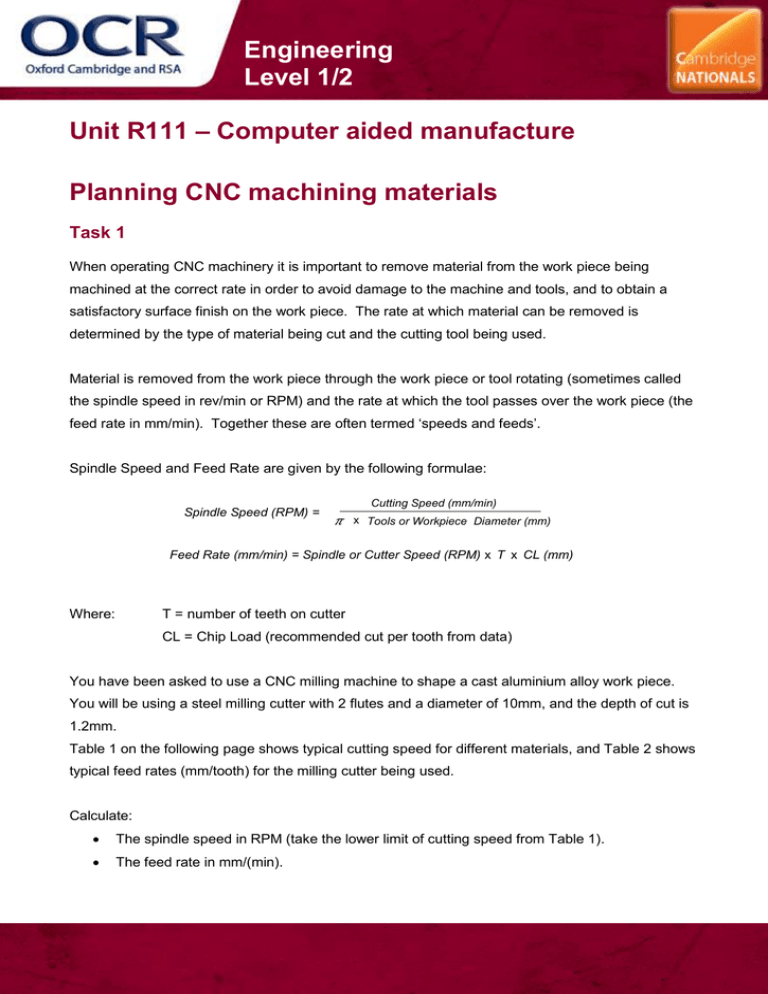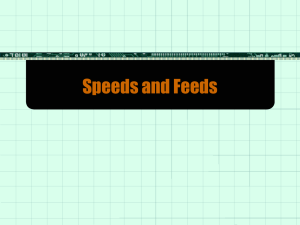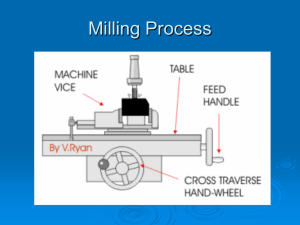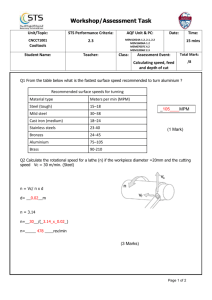Unit R111 - Planning CNC machining materials - Lesson element - Learner task (DOC, 513KB)
advertisement

Engineering Level 1/2 Unit R111 – Computer aided manufacture Planning CNC machining materials Task 1 When operating CNC machinery it is important to remove material from the work piece being machined at the correct rate in order to avoid damage to the machine and tools, and to obtain a satisfactory surface finish on the work piece. The rate at which material can be removed is determined by the type of material being cut and the cutting tool being used. Material is removed from the work piece through the work piece or tool rotating (sometimes called the spindle speed in rev/min or RPM) and the rate at which the tool passes over the work piece (the feed rate in mm/min). Together these are often termed ‘speeds and feeds’. Spindle Speed and Feed Rate are given by the following formulae: Spindle Speed (RPM) = Cutting Speed (mm/min) 𝜋 x Tools or Workpiece Diameter (mm) Feed Rate (mm/min) = Spindle or Cutter Speed (RPM) x T x CL (mm) Where: T = number of teeth on cutter CL = Chip Load (recommended cut per tooth from data) You have been asked to use a CNC milling machine to shape a cast aluminium alloy work piece. You will be using a steel milling cutter with 2 flutes and a diameter of 10mm, and the depth of cut is 1.2mm. Table 1 on the following page shows typical cutting speed for different materials, and Table 2 shows typical feed rates (mm/tooth) for the milling cutter being used. Calculate: The spindle speed in RPM (take the lower limit of cutting speed from Table 1). The feed rate in mm/(min). Engineering Level 1/2 If the work piece material is changed from aluminium to mild steel due to a design change what happens to the spindle speed and feed rate – and what does this show about the effects of material selection on spindle speed and tool feed rate? Use the lower limit of feed/tooth from Table 2. You could perform your calculations by hand or produce a simple spreadsheet to make the task of altering values such as cutting speed and feed/tooth simpler. Engineering Level 1/2 Table 1: Typical cutting speeds for different materials using high speed steel cutter Material type Cutting speed (m/min) Steel (high carbon) 15-18 Mild Steel 30-38 Cast Iron 18-24 Alloy Steels 20-37 Carbon Steels 21-40 Free Cutting Steel 35-69 Stainless Steel 23-40 Bronzes 24-45 Aluminium 75-105 Brass 90-210 Table 2: Typical feed rates (mm per tooth) for end mills (10 mm diameter, 1.2mm cut) Material type Recommended feed/tooth (CL) (mm) Plain Carbon Steel (mild steel) 0.051 – 0.08 mm High Carbon Steel 0.025 – 0.076 mm Tool Steel 0.025 – 0.076 mm Cast Aluminium Alloy 0.076 mm Cast Aluminium (hard) 0.076 mm Brasses and Bronzes 0.076 - 0.10 mm Plastics 0.10 mm



